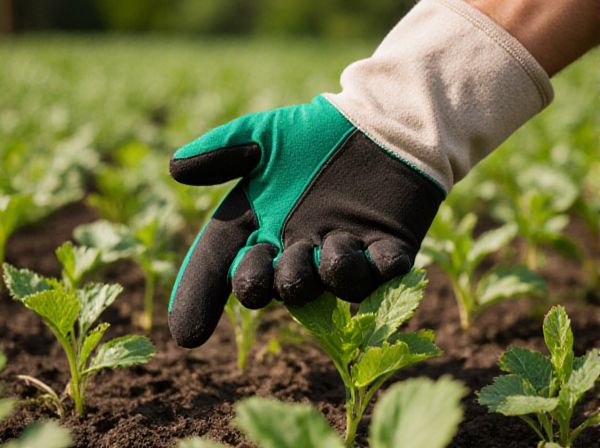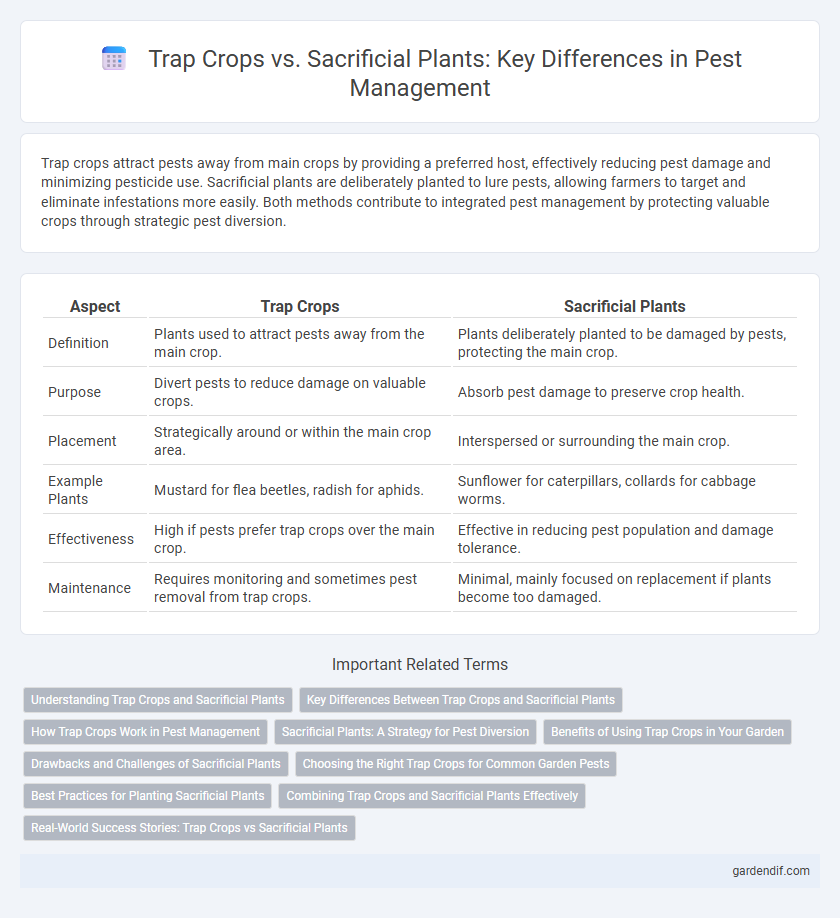
Trap crops vs Sacrificial plants Illustration
Trap crops attract pests away from main crops by providing a preferred host, effectively reducing pest damage and minimizing pesticide use. Sacrificial plants are deliberately planted to lure pests, allowing farmers to target and eliminate infestations more easily. Both methods contribute to integrated pest management by protecting valuable crops through strategic pest diversion.
Table of Comparison
| Aspect | Trap Crops | Sacrificial Plants |
|---|---|---|
| Definition | Plants used to attract pests away from the main crop. | Plants deliberately planted to be damaged by pests, protecting the main crop. |
| Purpose | Divert pests to reduce damage on valuable crops. | Absorb pest damage to preserve crop health. |
| Placement | Strategically around or within the main crop area. | Interspersed or surrounding the main crop. |
| Example Plants | Mustard for flea beetles, radish for aphids. | Sunflower for caterpillars, collards for cabbage worms. |
| Effectiveness | High if pests prefer trap crops over the main crop. | Effective in reducing pest population and damage tolerance. |
| Maintenance | Requires monitoring and sometimes pest removal from trap crops. | Minimal, mainly focused on replacement if plants become too damaged. |
Understanding Trap Crops and Sacrificial Plants
Trap crops attract and lure pests away from main crops by providing a more appealing alternative, effectively reducing pest damage and protecting valuable plants. Sacrificial plants are deliberately planted to sacrifice themselves by attracting pests that would otherwise harm the primary crop, often leading to targeted pest control measures on these plants. Both strategies optimize pest management by exploiting pest behavior to minimize crop loss and reduce reliance on chemical pesticides.
Key Differences Between Trap Crops and Sacrificial Plants
Trap crops attract specific pests away from main crops by providing a more appealing food source, effectively reducing pest pressure on valuable plants. Sacrificial plants, on the other hand, are intentionally planted to be damaged or consumed by pests, protecting primary crops by serving as expendable hosts. The key difference lies in the pest management strategy: trap crops lure pests for control or removal, while sacrificial plants tolerate pest damage to safeguard essential crops.
How Trap Crops Work in Pest Management
Trap crops lure pests away from main crops by providing an alternative food source or habitat that is more attractive to the pests. These plants concentrate pest populations in a controlled area, reducing damage to the primary crop and facilitating targeted pest control measures. Effective use of trap crops enhances integrated pest management by minimizing pesticide reliance and promoting ecological balance.
Sacrificial Plants: A Strategy for Pest Diversion
Sacrificial plants serve as a strategic tool in pest management by attracting pests away from main crops, effectively reducing damage and preserving yield quality. These plants, often more vulnerable or palatable to specific pests, create a targeted diversion that minimizes pesticide use and supports sustainable agriculture. Implementing sacrificial plants enhances integrated pest management by leveraging ecological relationships to control pest populations naturally.
Benefits of Using Trap Crops in Your Garden
Trap crops attract pests away from main crops, reducing damage and minimizing the need for chemical pesticides. They enhance pest management by concentrating pests in a controlled area, making it easier to monitor and eliminate them. This natural strategy promotes healthier plants and supports sustainable gardening practices.
Drawbacks and Challenges of Sacrificial Plants
Sacrificial plants often face challenges such as attracting pests without effectively protecting the main crop, risking significant yield loss. They require careful management, including timely monitoring and removal, to prevent pests from multiplying and spreading. Additionally, sacrificial plants may compete for nutrients and water, potentially weakening the overall crop system and increasing labor costs.
Choosing the Right Trap Crops for Common Garden Pests
Selecting effective trap crops involves identifying plants that specifically attract common garden pests away from valuable crops, such as using mustard to lure aphids or nasturtiums for aphids and whiteflies. Trap crops like radishes for flea beetles and collard greens for cabbage worms reduce pest damage by concentrating infestations in manageable areas. Choosing trap crops based on pest preferences enhances integrated pest management by minimizing chemical use and protecting main crops.
Best Practices for Planting Sacrificial Plants
Planting sacrificial plants involves selecting species that attract pests away from primary crops, ensuring they are sown at the field edges or strategic locations to intercept pest movement. Optimal spacing and timing align with the pest's life cycle to maximize effectiveness and reduce pest populations sustainably. Regular monitoring and removal of heavily infested sacrificial plants prevent pest overflow and maintain crop health.
Combining Trap Crops and Sacrificial Plants Effectively
Combining trap crops and sacrificial plants enhances pest management by attracting pests away from main crops and providing alternative feeding sites that reduce overall pest pressure. Strategic placement of trap crops around field borders alongside sacrificial plants interspersed within crop rows ensures maximum pest diversion and containment. This integrated approach supports sustainable agriculture by minimizing pesticide use and promoting ecological balance.
Real-World Success Stories: Trap Crops vs Sacrificial Plants
Trap crops have demonstrated significant success in cotton farming by attracting boll weevils away from the main crop, reducing pesticide use and increasing yields. Sacrificial plants, such as in rice cultivation, have effectively diverted pests like stem borers, protecting valuable grain while simplifying pest management. Real-world applications highlight trap crops' efficiency in integrated pest management, whereas sacrificial plants offer a cost-effective, low-chemical alternative in diverse agricultural systems.
Trap crops vs Sacrificial plants Infographic

 gardendif.com
gardendif.com